
The Royal Tank Regiment (RTR) is the oldest tank unit in the world, being formed by the British Army in 1916 during the First World War. Today, it is the armoured regiment of the British Army's 12th Armoured Infantry Brigade. Formerly known as the Tank Corps and the Royal Tank Corps, it is part of the Royal Armoured Corps.

The 4th Armoured Brigade was an armoured formation of the Australian Army established during the Second World War. It was formed in February 1943 to provide armoured support for infantry units operating in the South West Pacific Area. Its composition varied over time, but usually comprised several armoured regiments equipped with Matilda II or M3 Grant tanks as well as some support units.

The 6th Royal Tank Regiment was a regiment of the Royal Tank Regiment, of the British Army, until 1959. It originally saw action as 6th Battalion Tank Corps in 1917.

The 44th Royal Tank Regiment was an armoured regiment of the British Army, which was part of the Royal Tank Regiment, itself part of the Royal Armoured Corps that saw active service in World War II.
The 45th Royal Tank Regiment was an armoured regiment of the British Territorial Army that fought at the Battle of Alamein during World War II and continued to serve during the 1950s.
The 43rd Royal Tank Regiment was an armoured regiment of the British Army's Royal Armoured Corps that tested and demonstrated specialised Armoured Fighting Vehicles during World War II.
The 51st Royal Tank Regiment was an armoured regiment of the British Territorial Army that fought in the Tunisian and Italian campaigns during World War II and continued to serve during the 1950s.
49th Royal Tank Regiment, later 49th Armoured Personnel Carrier Regiment and 49th Armoured Carrier Regiment, was a regiment of the British Army's Royal Armoured Corps during World War II that operated specialised armoured fighting vehicles in North West Europe.

The 21st Army Tank Brigade was an armoured brigade formation of the British Army active during the Second World War. The brigade served with the British First Army and the British Eighth Army during the fighting in Tunisia and Italy.

The 23rd Armoured Brigade, originally formed as the 23rd Army Tank Brigade, was an armoured brigade of the British Army that saw service during the Second World War. The brigade was a 2nd Line Territorial Army (TA) formation. It was reorganised and renamed the 23rd Armoured Brigade, when it was assigned to the 8th Armoured Division, although it never operated under command of the division.

The 10th Armoured Division was an armoured formation of division-size of the British Army, raised during the Second World War and was active from 1941–1944 and after the war from 1956–1957. It was formed from the 1st Cavalry Division, a 1st Line Yeomanry unit of the Territorial Army (TA) which had previously been serving in Palestine. The division was converted from cavalry to armour and redesignated from 1 August 1941.

The 144th Regiment Royal Armoured Corps was an armoured regiment of the British Army. Originally raised during World War II as a battalion of the East Lancashire Regiment it was later transferred to the Royal Armoured Corps. It fought in the campaign in North-West Europe, from June 1944 to May 1945.
The Leeds Rifles was a unit of the 19th century Volunteer Force of the British Army that went on to serve under several different guises in the World Wars of the 20th century. In the First World War, both battalions served as infantry on the Western Front. They were later converted into an anti-aircraft and tank units, and fought in North Africa, Italy, and Burma during the Second World War.

The 34th Armoured Brigade was an armoured brigade of the British Army that fought in the Second World War. It was formed in 1941 as the 34th Army Tank Brigade and renamed as the 34th Tank Brigade in February 1945, becoming part of the 79th Armoured Division. It was equipped with Churchill tanks and provided close support for assaults by the infantry. During the fighting in North-west Europe from July 1944 to May 1945 the brigade served with the First Canadian Army and the British Second Army. The brigade was disbanded in early 1946.
The 142nd (Suffolk) Regiment Royal Armoured Corps was an armoured regiment of the British Army's Royal Armoured Corps that was raised in World War II and saw active service. The regiment served in the final stages of the North African Campaign at Tunisia and later served during the Italian Campaign from 1943 until early 1945 when it was disbanded.
Major-General Arundell Rea Leakey, was an officer in the British Army. He served in the Royal Tank Regiment in the Second World War, in North Africa, Italy and France. He later served in Korea, in the Arab Legion, and commanded a brigade in the British Army of the Rhine in the 1960s. He served as Director-General of Fighting Vehicles and finally as the commander of British troops in Malta and Libya. He retired in 1966, and became Director of the Wolfson Foundation. An autobiography, Leakey's Luck, was published in 1999.

Malta Command was an independent command of the British Army. It commanded all army units involved in the defence of Malta. Once mobilised the Command deployed its headquarters to underground hardened shelters and its combat units were deployed to fixed points in the Maltese countryside, from where they operated. This mobilised, but largely static, army garrison would be tested by aerial bombardment and naval blockade during the Second World War. Whilst Malta Command was already a functioning command structure before 1939, the Second World War would see the Command operate as a genuine war-fighting headquarters, albeit in a static defensive role.
















